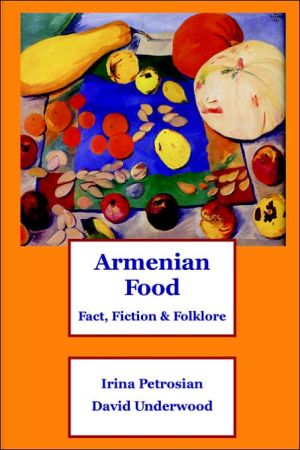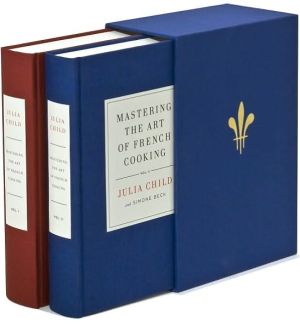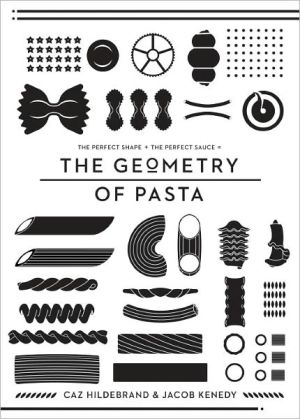Armenian Food: Fact, Fiction & Folklore
Food is the portal to Armenia's past and present-day culture. This culinary journey across the land called Hayastan presents the rich history, wondrous legends, and fact-filled stories of Armenian cuisine. Authors Irina Petrosian and David Underwood take readers on a memorable and sometimes humorous tour of Armenia by way of the kitchen. What ancient Armenian fable warned against genetically-altered food? \ What little-known Armenian fruit may have helped Noah on the ark? \ What was the diet...
Search in google:
Food is the portal to Armenia's past and present-day culture. This culinary journey across the land called Hayastan presents the rich history, wondrous legends, and fact-filled stories of Armenian cuisine. Authors Irina Petrosian and David Underwood take readers on a memorable and sometimes humorous tour of Armenia by way of the kitchen. What ancient Armenian fable warned against genetically-altered food? What little-known Armenian fruit may have helped Noah on the ark? What was the diet of David of Sassoun, the legendary Armenian Hercules? What was the influence of the Soviet Union on the food ways of Armenia? What strange and exotic fruits and herbs are sold in Armenia's markets? Why do Armenians go to cemeteries to "feed" the dead? What role did coffee and lavash bread play in Armenian marriage rituals? These questions and more are answered in this first modern guide to Armenian food. If you are curious about one of the world's most ancient cultures, or are contemplating a trip to Armenia, don't miss the chance to read this book. Includes rare photos and illustrations, notes and sources, and index.
TzhvzhikWhen meat is frying in a skillet, the English-trained ear hears the sound "siz-siz-siz", thus the word "sizzling" in the English vocabulary. Armenians hear "tzh-vzh-tzh". So they named their dish of liver fried in hot oil tzhvzhik.The main ingredients of tzhvzhik are liver and onions. After cutting the meat into small pieces and sprinkling with salt, cooks brown it in the skillet. Placing the liver onto a serving platter is the next stage. Then sliced onion is added to the same skillet and sautéed until lightly brown. Liver covered with the sautéed onions is then ready for enjoyment. Fried liver is a non-pretentious dish. Its popularity spans across the Near East and the Balkans. In Turkey, the dish is called arnavit jigeri, "Albanian liver", and is considered as a contribution of the Albanians to the Ottoman cuisine. But Armenian fried liver is especially noteworthy because there's a great yarn behind it.That story is called Tzhvzhik. Its main theme is that food obtained through charity comes with an emotional price tag. It creates a conflict between the desire for self-respect and the hunger for food. The author, Atrpet, published many volumes of literature, but Armenians only remember his small, five-page story about tzhvzhik. The story gained prominence after the 20-minute-long movie version of Tzhvzhik was released in 1961. This film is considered a classic of Soviet Armenian cinematography. Some memorable lines of dialogue from the movie became widely used idioms. The movie offers a glimpse of life in the Armenian town of Erzerum in the Ottoman Empire, at the end of the 19th century. In a close-knit community, food was one of the main topics of discussion. Everybody knew through the grapevine what was on each other's table for dinner. The status of town inhabitants was measured by the number of visits to the butcher shop, which was pretty much the center of the Armenian universe. A surviving trace of the importance of the butcher in the lives of Ottoman Armenians is the Armenian family name Kasabian (Kasab means butcher in Turkish). In the movie, a poor man, Nerses Aga, happens to meet the affluent Nikogos Aga at the butcher shop. In a generous gesture, the latter buys a big piece of liver for the impoverished fellow. But Nerses never gets to savor the tasty gift. He watches with anguish, his mouth watering, as his hungry family wolfs down all the tzhvzhik in scant minutes. He doesn't get to taste a single piece.From that moment on, whenever he runs into Nikogos Aga, he gets reminded again and again about the gift he accepted. Then it seems everyone he encounters has to talk about tzhvzhik. He must listen to unsolicited comments about its delicious flavor, its proper preparation, and how to economize such a tasty treat. "Use only half of the meat for the first-day tzhvzhik. Drain away all the fat after frying it, and use that for making next-day tzhvzhik." Nerses Aga starts to lose it badly. Wherever he goes, he begins to hear people seeming to whisper behind his back, "Tzhvzhik...tzhvzhik". Finally, his nerves can't take anymore, and he snaps. The climax of the story is both dramatic and quite funny. In a near frenzy, the angry and tormented Nerses Aga grabs a huge, whole piece of liver from that same butcher shop. He finds Nikogos Aga, and slaps the fresh meat straight into his benefactor's face, right out in public. "Here's your tzhvzhik! Here's your tzhvzhik!" he howls in frustration at a very shocked, stunned, and liver-stained Nikogos Aga."Charity exacerbated the resentment felt by the recipient", modern psychoanalysts would say. The expression "don't make a story about tzhvzhik" became part of Armenian colloquial language. It's used when there is too much curiosity or a bit too much talk about a particular dish and how tasty it is.It's impossible to discuss tzhvzhik and not mention the special place that liver takes in the Armenian emotional makeup. The Turkish word for liver, jigiar, is rarely used by modern Armenians as the name of the bodily organ. Rather, it is used to refer to the center of strong human emotions. It is considered a term of endearment. In Armenian, to have a strong love is to love with the liver. To be a cold, aloof, selfish, in the same terms, is to be "without liver" (anjigiar). A refrain from a popular song by the well-known Armenian singer Tata is "Jigaryov ser, uzum em jigyarov sirel." "Love with the liver, I want to love with the liver." Don't forget that Armenians are just affirming that the English word "liver" comes from the word "live".Want an interesting definition of Armenia? It is a country where people not only enjoy fried liver, but also love with their liver, feel pain in their liver, talk with their liver, and "eat with their liver", which means to dine with gusto.You can feel this at the moment you step into Zvartnots Airport in Yerevan. Armenians there are passionately kissing and hugging each other in the arrival and departure areas. That's the emotional "liver" at its very best. Tzhvzhik cooking at the barbecue parlors right outside the airport, now that's the real liver.
INTRODUCTIONCuisine Shaped by HistoryOld YerevanA Taste of the Soviet TimesDining in Soviet Yerevan in the 1920sThe Soviet Armenia CookbookArmenia's Natural ProduceFOOD OF ARMENIABREADLavashWrapsOnce Upon a Time ...MatnakashLore and SymbolismMay You Never Have a Longing for BreadCHEESE, YOGURT AND BUTTERCheeseYogurtButterLore and SymbolismGRAINS AND PASTAGrain DishesHasoodaHarissaPastaThe Kukuruz CrazeMEAT AND FISHSymbol of PlentyKhorovatsTolmaTzhvzhikKhash KuftaKhashlamaA Village Woman's LifeKhinkali Kchooch, Bozbash, and BorschtClay's ComebackBasturmaFishVEGETABLESPotato and CabbageTomato and CucumberEggplant and PeppersAt the BazaarFRUITSApricotGrapesPomegranateApplesWatermelon As MedicineThe Fruit VaseOther FruitsHERBS AND SEASONINGSAghaman - The Salt JarBEVERAGESDid Churchill Like Armenian Brandy?CoffeeSWEET TREATSTortes and CakesDried FruitsMoorabaFEASTS, FESTIVALS AND MORERITUALS, TRADITIONS AND ETIQUETTEOld Style Table EtiquetteMenu of the Armenian Urban EliteTaking Tea in Old ArmeniaThe Matagh RitualHow to Prepare Sheep for MataghThe Lenten TableA Perspective on Sheep and MouflonsFeeding and Honoring The DeadKefToastingFeasting Soviet-styleWinter Fun with Ancient FoodsSunflower SeedsHISTORY ON A PLATEKing Tigran's TableMedieval Feasts of Armenian NoblesArmenia's Strong Man DietFeasts for WesternersWORD FLAVORSFOOD LANGUAGE"Russenanian"Words: Why and HowGlossary of Culinary TermsNOTES AND SOURCESART & PHOTO CREDITSINDEX OF RECIPESARMENIAN COOKBOOKSINDEX








